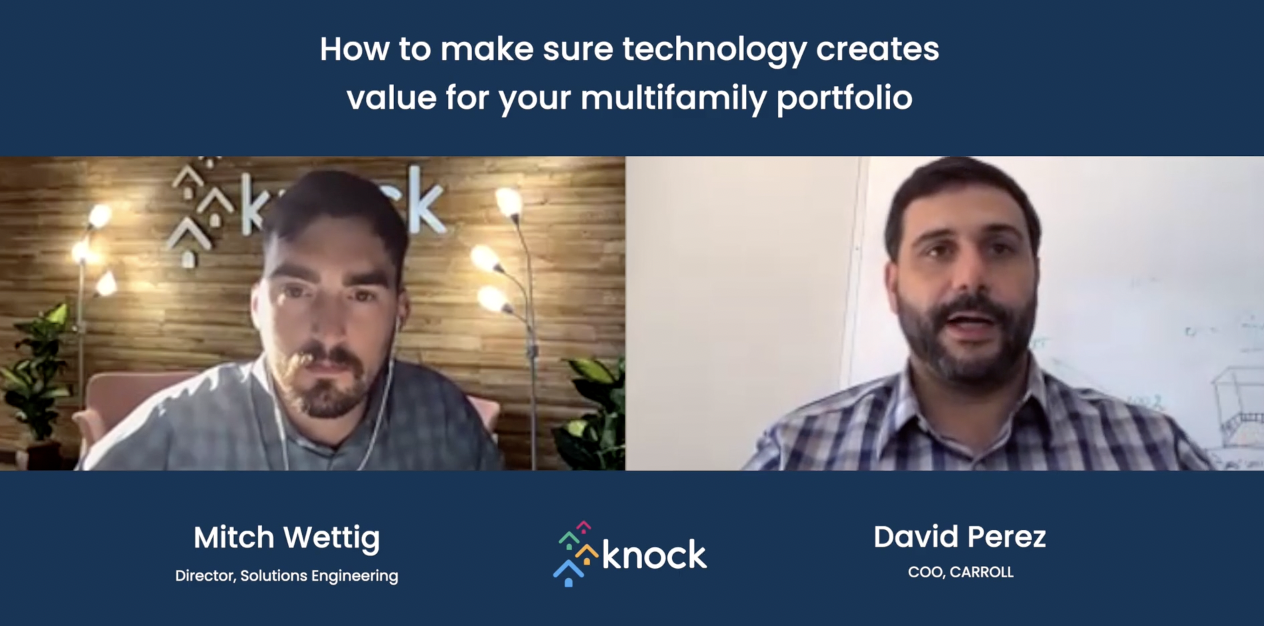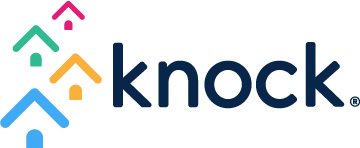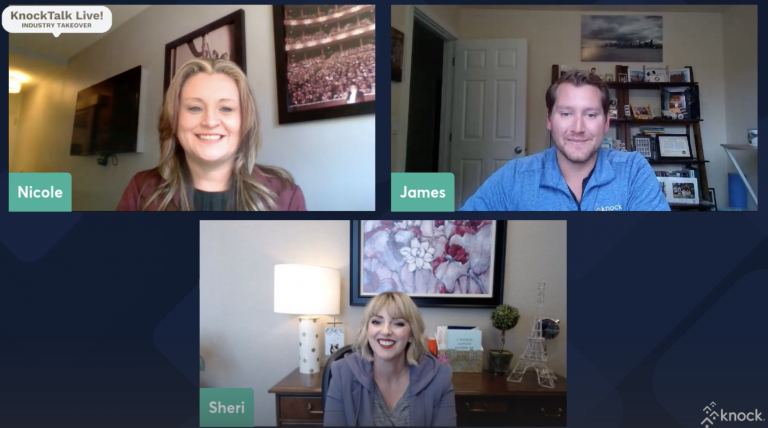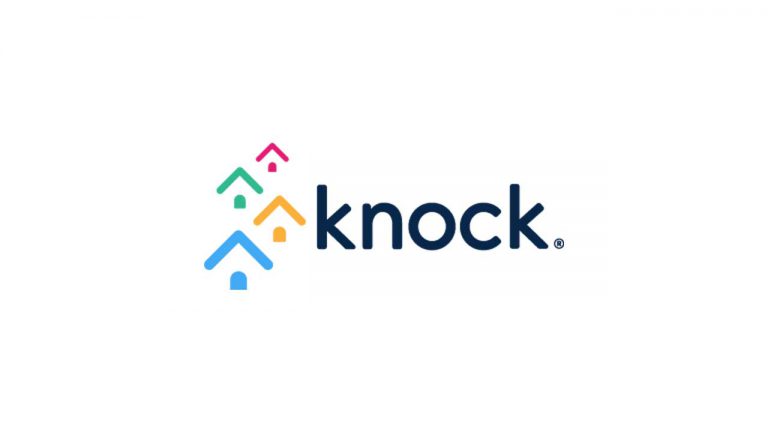Knock Talk: Ep. 14 – The 4 Ps of multifamily technology strategy with CARROLL’s David Perez

With an ever-expanding list of multifamily technology solution providers, how do you choose a partner that creates value for your portfolio(s), and solves pressing problems?
David Perez, COO of CARROLL, an NMHC Top 50 Owner and Manager, uses the 4 Ps: process, people, product (aka, the technology) and platform.
Mitch Wettig, Knock’s director of value engineering sat down with David to talk all about this and more in our latest Knock Talk. Watch the episode or read the transcript below.
Watch the episode or read the transcript below.
Transcript
David Perez: Part of my challenge is how do we do digital transformation efficiently and effectively? And then how do we employ, and right size company? How do we put the right processes in place, identify people that have the right skills and hire those people to do those things bigger, better, faster, stronger.
Then, on the bigger, better, faster stronger really comes in with technology. It’s really that last overarching piece that enables you to go, ‘I want to serve this customer at this point in time, in this way – now how do we do it so it feels personal and timely, and gets our message across effectively?’
Mitch Wettig: Got it. Thank you David. Those are great points. It sounds like you’re looking at three facets. It’s process. Then it’s people. Then it’s technology.
It sounds like technology – the way you’re thinking about it – is more supplement versus supplant. You’re not looking for technology to replace anything in particular, but act as an aide to the processes and the people that you have, so you can scale. You guys are an NMHC Top 50 – a lot of units, a lot of properties, so these decisions are affecting more than a few properties. Would you say that most of your technology you have rolled out is across your entire portfolio?
David Perez: Yeah, that’s right. We like to be platform – and deploy across the platform – because training is such a key component. Not only do we want to be training on the same process or the same skill sets we want people to develop. But then those trainings translate to ‘how do I actually use these tools efficiently and effectively?’ And, when you have differing tools, for one reason or another, you’ve got different training sets. And, frankly the turnover that exists in the industry – you’re training somebody new on something new probably every week if not more often than that. So, having consistency around how you run things and being able to measure the success of how you run things can help standardize and make sure you can get the lift that you’re expecting.
Mitch Wettig: For sure. And, since the topic of this discussion is how to make sure technology create that value for your portfolio, when you take something like training, do you lean heavily on the vendor or the technology service that is being provided from their training, or is that something you guys do in-house and create a process around that internally?
David Perez: That’s a great question. It’s a little bit of both. We had some things up in the air, with how they would tie together and fit in, but we knew we needed to move quickly early on, so we asked vendors to do a little bit more of what their out of the box training was. Since then, we’ve ironed out a lot of our process about how we think about customer journey or employee engagement. We’ve really asked any vendor that’s coming in and deploying software to work tightly with our training team to make sure that the new training is highly customized to our view of the world.
So, moving forward, it’s really going to be take the two training teams, and make sure they create a joint deck that consist of the technical aspects that must be taught, and that vendor teams have more expertise on – we certainly want to convey those; and our training team that goes, this is how it fits in our process and what we are asking you to go do.
Mitch Wettig: Got it. So, blending your SOPs with vendor best practices. Looking at Knock, we’ve rolled out to hundreds and hundreds of clients, and we really have a good process that we feel is great. But, we certainly have to match what you guys are doing onsite, and make sure it does scale across your entire portfolio. A lot of the topics of discussion for this conference, and a lot of the sessions I’ve already sat in on are, ‘COVID opened the eyes of a lot of folks who have been sitting on or have been latent with tech decisions.’
What have been some of the technology decisions that you’ve looked at or maybe already implemented during COVID and why?
David Perez: So, they’re more periphery kind of technologies. Pre-COVID, we had really sat down and analyzed the entire customer journey. We created our own customer journey model – we call it the EASE model. It just really walks someone through from lead to moving in with us, and their experience with various touchpoints along the way, and there’s tools we use along the way to do that. We had already built a roadmap on what we wanted to tackle.
I think set along the side were things like virtual touring maybe some additional touchless kind of touring, additional ability to showcase or give someone a virtual experience, whether it’s online or with tools you can embed on your website – or things like that. Things that were like, we’ll get around to this eventually, right? But now, all of a sudden oh you can’t come in person, so it jumps up to the top. So, the way we really thought about what needs to jump to the top was, where’s our customer? Well, our customer is at home. They can’t come see us. Our employees aren’t allowed to see you. Our offices just opened up to thru traffic. Most of it had been closed and scheduled-only, appointment only concepts.
We had to really understand where our customers were in that journey cycle and what we needed to do to meet them there – if they wanted to move, if they wanted to see an apartment – those kinds of things. We were fortunate that we had already moved to 100% online payments, so we had no other traffic coming to the office for checks. We had implemented Knock back in 2018, so we had met them there on an interactive platform CRM that allowed our employees from anywhere to interact with anyone – and understand them more with two way communications. Knowing those kinds of things. And, there’s a few other bells and whistles that we probably have out there through rentcafe – our Yardi Platform and where we do some leasing and stuff. So, that’s really how we thought about moving quickly through COVID.
Mitch Wettig: Absolutely. It sounds like you built the roadmap. You were flexible about looking at where customers are right now. And where is our team right now, and what can we add on to supplement and accommodate a process that is largely remote. When it came to prioritization of some of the major or more longer-term implementations that you have, versus the short-term, let’s do something that allows our customers to have that virtual leasing experience/process how do those prioritizations take place? And, is the roadmap still generally the same, but maybe just reconfigured?
David Perez: Yeah, that’s a great way to say it. I mean we just said, these things are now a bigger priority than they were before. You know, going into COVID we were really focused on lots and lots of customer experience type things, and it’s not to say that we weren’t, but there’s a bigger lift to get to where we want to if we want to replace a platform that’s so embedded or so part of what our people do on a day-to-day basis. And, when we’re asking them to all of a sudden shift to very in-person – you know we asked everybody to make a phone call every day to 20% of their resident base, so that we’re touching residents every single day. Asking them to do a lot of person to person outreach even if it’s via phone or email, just checking in. Which may have been easier if we had another platform out there, which would have made some of that two-way communication easier, we were not ready to move forward with some of Knock’s capabilities with resident communications. I think there were just some additional things – and everything was moving so quickly that we felt traditional methods of outreach were going to be more successful for customer retention, so we said let’s focus our efforts around new technologies around spaces where we have barriers – like literally have barriers, like government barriers – that won’t allow us to do things: like have people in our office, do tours, and show off certain units and stuff.
Mitt Wettig: Right. So, let’s talk about that. Some of those news technologies. What does the vetting process look like for you when you’re considering a new technology?
David Perez: So, it really gets down to – and I’ve challenged our team internally to show me a process map or a workflow of how we need to work based on on how we believe how the customer needs to be interacted with, and how on whether it’s certain regulations, or how with certain constraints, things need to exist on certain systems – and we start with that framework in mind. Then, we develop a future state that, and say, ‘it would be nice to insert something right here in this spot to help us do XY and Z. So then, let’s go and have 4 or 5 different conversations and dig up who we think might be able to fit this hole. And essentially, we pitch it to them. We’re like, essentially we’re trying to get to this workflow and we need you here, can you do that?
A lot of times you hear “no,” and we go, “ok, then listen, I’m not going to bend over backwards and change for you. I’m really going to need you to change for me, so that we can do what we want to do.” I get there are technology constraints, and the current ERP landscape isn’t fantastic in what it allows you to do and not do in systems. And, you can find people who are creative, and who will try and work with you and really the name of the game is they can’t make it harder on us when we’re trying to deploy something. So, that’s really a high-level overview of how we think of vetting vendors through a selection process.
Mitt Wettig: Got it. So, definitely more qualitative, and really matching the workflows you already have, or meeting in the middle somewhere to blend your guys’ need with what the technology is capable of. Is there any sort of quantitative analysis or measurement on, ‘how is this going to impact my NOI’? Price? I’ve been on the vendor side for about 4 years now – both at price leaders in the industry. A lot of what we have to do is get someone to think outside of ‘how much does it cost?’ to ‘What is this going to drive for me? “ And how is this going to impact my NOI? I’m curious to hear from you about how you think about the quantitative side of it.
David Perez: Yeah, you know, look NOI is a nice lag indicator – like, all things should point to improved bottom line results, right? I like to think through, well what are my leading indicators? What are my things I really need to change, and what is this product going to do for me? Is this going to improve my conversion ratios? Is this going to decrease my advertising? Is this going to decrease my dependence on, you know, certain folks in place. Can I change how I now market? Is there a bigger brand kind of play? Will I get more data out of this to understand where people are coming from that helps me target a little more?
And getting into some of those nuance-type metrics and workflows, and working with vendors to say, ‘hey look, what are you really solving here?’ Everyone likes to throw around, ‘we save you money,” or ‘we generate more revenue,’ and sure. But, what is the problem you’re really solving, and then keying in on those metrics and saying – alright, is it actually solving that problem? Am I seeing more conversions? Can I track where my leads are coming from? Those kinds of things, and those kinds of questions, and then holding them accountable to the backend. Obviously results are going to show up in the bottom line. And you don’t know whether it’s truly working, and you may have to play around with some things and some of the leading indicators and how you configure things up front.
Mitt Wettig: You gotta be able to tie correlation to causation. So, when you talk about at least first wanting to understand is this actually doing what they said it would do – I know the multifamily industry is used to trials or pilots, tell me about that – and in those scenarios, are there hard benchmarks you set or KPIs that you’re looking at? You kinda already answered this question, but in the vein of a trial period, knowing you’re not going to get a full year over year look.
David Perez: It’s going to be the same. You’re going to want to set up a sorta hypothesis test and have some that are on, and some that aren’t so you can look at side-by-side results the best that you can. And it just really depends on the type of product and what you’re going after, and the kind of results you theorize. And, it’s more about setting up a hypothesis and having the right measurements in place. And having a good benchmark or a placebo, right in the medical world. You’re telling them all the same things, and they should be doing the same process, but you know, instead of using the tool they’re doing it the old way, and now you can measure side by side.
I think it’s important – at least in our world – we have to do a fair amount of selling and conviction once we like a product with some of our partners and those things, and getting them onboard with like, “I really think this could work. And we’re able to say look, we’ve already tried it over here on the side. Here are the results. Let’s give it a shot across the portfolio. And then, you show them the results and things and how they worked out.
The other great thing about trials is that you can work out the kinks. And you can select your best teams and your best performers, and people who can overcome challenges and have the process already down. So, they can give you the good, bad and ugly about the product and what’s going on. Do they like it? How’s the user interface? Can they make things actually speed up? Is it effective for the team? All those questions can be answered by a key group of people who are testing stuff out for you. And, it really brings them in the decision making too. If you like the product, and let’s go into change management. I need a “rah rah” team around this new thing. They become that cheerleading team for you.
Mitch Wettig: Creating an internal champion is always going lead to quicker adoption. Having someone internally carry the flag is critical. So, we’ve got time for about one more question and then I’ll open it up to additional questions from some of the participants. When it comes to ongoing performance, we talked about the trial, and setting up those KPIs, but when you look at a blend of reporting you get from your technology vendor versus some of the internal reports you look at or internal analysis you do – how do you measure success? And again, how are you able to draw a thread from correlation to causation to be able to say, this product that we brought on did move the needle for NOI or return on investment, things like that.
David Perez: That’s a little more challenging, especially if you’re ongoing, and you don’t want to rip and replace stuff all the time. But, what you want to do is continually try and improve. And, at some point, if a product can never improve, you’re going to eventually migrate away from it, and you’re going to see degradation there. Things we really ask our vendors to do is set up a quarterly cadence with us to review high level performance, and go over what they’re seeing, best practices, and it can’t just be like, ‘hey, renewal is coming up, let’s just check back in and make sure this last year was fine.’ And then, I think teams have done a better side, on the B2B side, they have the backend client success managers that will check in and be responsive if you have issues, if you have challenges. That’s a key use. That’s a key piece. But, communicating along the way, and saying, ‘hey, we’ve got these things, we’ve noticed these kind of trends. Let me bring you what some other clients have been talking about and asking about. Those are all key things the software, or whatever you’re implementing that that business team is in tune with your business and looking out for you. That’s a more qualitative metric that I like to see. I don’t like someone to sell me something and disappear.
Separately, it’s obviously the KPIs. It’s whatever you set up front. And if it’s just not working, you got sold a bag and it’s just like, ‘this is a gigantic mess’ and operations is all frustrated, and we’ve given it our try, and I’ve been back and forth with client success. And, we’re not seeing the lift we expected, then it totally doesn’t make sense.
Mitch Wettig: Just being on the vendor side, one of the frustrating things is when you’re talking to a client that has those problems that you’re speaking of whether it’s something that they were sold something that didn’t live up to the hype or there were onboarding problems. Now, as the vendor who is trying to instill confidence in that process, there’s definitely a lack of trust because they have already been through that process and been left. There’s a lot of shortcomings. It doesn’t just impact the software they are implementing. They remember it, and it impacts future decisions.
David Perez: Yes. And, all the people remember that too.
Mitch Wettig: Well, David thank you so much for your time. That was a great discussion.


